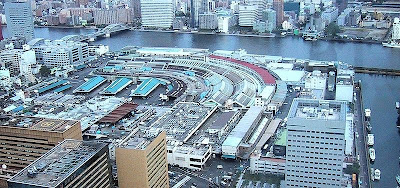 Tokyo used to be the largest city in the world. There is no denying upon first sight that the place defies both logic and the imagination. An ancient capital festooned with one-way streets to confuse the emperor's enemies, a third of it was destroyed in the war but to them the logical thing to do was to rebuild it exactly as it was before. There is no zoning in the city so it is not at all unusual to see a single-family home made of wood and cross beams directly across the street from some of the tallest office towers in the country.
Tokyo used to be the largest city in the world. There is no denying upon first sight that the place defies both logic and the imagination. An ancient capital festooned with one-way streets to confuse the emperor's enemies, a third of it was destroyed in the war but to them the logical thing to do was to rebuild it exactly as it was before. There is no zoning in the city so it is not at all unusual to see a single-family home made of wood and cross beams directly across the street from some of the tallest office towers in the country. What Tokyo does have is the largest wholesale fish market in the world and that is
 "Tsukiji (Skee-gee)." Under one massive room comes marine life from across the planet in volumes to provide some 95% of the seafood enjoyed by the nearly 13 million good people of Greater Tokyo. It's not for early riser or the squeamish and is certainly not a tourist attraction in any way, shape or form but it is tolerant of the curious who respect the rules and rhythm of the place, mainly to not touch the products and absolutely to stay out of the way of the trading.
"Tsukiji (Skee-gee)." Under one massive room comes marine life from across the planet in volumes to provide some 95% of the seafood enjoyed by the nearly 13 million good people of Greater Tokyo. It's not for early riser or the squeamish and is certainly not a tourist attraction in any way, shape or form but it is tolerant of the curious who respect the rules and rhythm of the place, mainly to not touch the products and absolutely to stay out of the way of the trading. The liveliest action is when the tuna catch arrives between 1AM and four in the m
 orning. Massive flash-frozen carcasses are carted hither and yon to bidding rooms where the callers put any auctioneer in Britain or New York to complete shame. The Japanese language is tricky enough, usually spoken at a rapid and staccato clip but speed that up by a factor of 20 and throw in fish jargon on top of that? Oi.
orning. Massive flash-frozen carcasses are carted hither and yon to bidding rooms where the callers put any auctioneer in Britain or New York to complete shame. The Japanese language is tricky enough, usually spoken at a rapid and staccato clip but speed that up by a factor of 20 and throw in fish jargon on top of that? Oi.After the buzz and sing-song of the tuna auction though there remains more than a million varieties of aquatic life to ogle, gag and gawk over. Most of the stalls are family owned and typically staffed by a husband-wife team, he doing the legwork and cleaning while she manages the till an
 d keeps the books.
d keeps the books. As can be expected many are handed down through the generations so there seems hardly a shortage of young and older sons learning the trade and, of course, doing the harder chores while the old man teaches and protects from the shadier traders on the floor.
The amount and variety of seafood passing through on a daily basis is beyond normal comprehension. Some are frozen, others are gutted on the spot while more than a few types are kept alive for transport to the display tanks of restaurants and retail markets around the city. It seems of all the varieties of squid in the ocean only the giant and the Humboldt squids are not served at the Japanese dinner table - seemingly every other type was there, waiting for the
 ginger and wasabi. As can be expected there are more than a few sushi bars and restaurants lining the road to the market where the freshest of the fresh can be sampled "day of catch."
ginger and wasabi. As can be expected there are more than a few sushi bars and restaurants lining the road to the market where the freshest of the fresh can be sampled "day of catch." All ya gotta do is get up at the crack of or before dawn, find your way to the "Hibiya" metro line and wear clothes that can be destroyed as soon as you leave the place. The smell of fish, fish guts and oils gets in to everything and everyone on the subway, in the streets and back at the hotel will smell you coming just as you can smell the market long before it comes in to view.
By all means stay out of the way. If you don't speak Japanese bring someone who does or at least has been before. They don't have time to deal with tourists and while they tolerate visitors are not there for your amusement or to serve as some kind of information counter. Whether or not you ever eat another piece of fish after that is entirely up to you!
Gotta go.
No comments:
Post a Comment